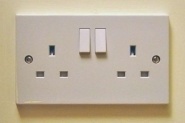Electric Power Facilities
There are two basic types of power lines: transmission lines and distribution lines. Transmission lines are high-voltage power lines.
The high voltage allows electric power to be carried efficiently over long distances from electrical generation facilities to substations near urban areas.
In the United States, most transmission lines use alternating current (AC) and operate at voltages between 50 and 765 kV (lkV or kilovolt = 1000 V).
The high voltage allows electric power to be carried efficiently over long distances from electrical generation facilities to substations near urban areas.
In the United States, most transmission lines use alternating current (AC) and operate at voltages between 50 and 765 kV (lkV or kilovolt = 1000 V).
Utilities use lower-voltage distribution lines to bring power from sub-stations to businesses and homes.
iDIstribution lines operate at voltages beloW
50 kV. F
or residential customers, th
ese levels are further reduced to 120/240 V once the power reaches its destination.
iDIstribution lines operate at voltages beloW
50 kV. F
or residential customers, th
ese levels are further reduced to 120/240 V once the power reaches its destination.
Sockets
Sockets may be wired on ring circuits or radial circuits. Mostly rings are used, as they use less copper for most circuit layouts, they have safety advantages over radial circuits (sometimes debated), can provide more power, and cover more floor area per circuit.
Ring
Sockets are on 32A ring circuits in most house installations. These use a ring of cable (ie a loop), so that at the CU 2 cables are connected to the MCB instead of 1. An unlimited number of sockets may be connected on each ring.
One ring circuit per floor is a fairly common arrangement, but by no means the only option. Larger houses generally have more rings. Its also common to have a ring dedicated just for sockets in the kitchen since that is where you will find many of the highest power consumingappliances in a modern house.
2.5mm² cable is usually used for ring circuits. 4mm² is used when cable will be under insulation or bunched with other cables.
Spurs
Spurs are permitted, but sockets should be included in the ring rather than spurred wherever practical. Spurring is best only used for later additions to circuits.
Rules apply to the loading and number of sockets allowed on the end of a spur.
Spurring sockets prevents the easy later addition of more sockets in some positions, as a spur may not be spurred off a spur. Spurs also prevent the addition of more sockets at existing spurred positions, whereas a practically unlimited number of sockets can be added where a socket is in the ring. Bear in mind the number of sockets wanted has risen greatly over the years, and can only be expected to rise further.
Radial
Radial socket circuits are used less often. These use a single cable from CU to socket, then a single cable to the next socket along the line etc. Radials use more copper on most circuits, though less cable on physically long narrow shaped circuits. Connection faults have greater consequences than with ring circuits. (Confusion over the relative safety of ring & radial circuits is widespread.)
- 20A radials use 2.5mm² or 4mm² cable.
- 32A radials use 4mm² cable


No comments:
Post a Comment